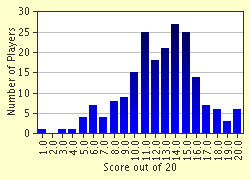Quiz Answer Key and Fun Facts
1. What does legato mean?
2. Where do accidentals go?
3. What is the key signature of G major?
4. What is special about marking tones in a harmonic minor scale?
5. What must we do in harmonic minor scales?
6. How long is a dotted crotchet rest in beats?
7. Are the raised 7ths in a harmonic minor scales included in the key signature?
8. What happens to single quavers?
9. What is the key signature of A minor?
10. What does rallentando mean?
11. What does the dominant triad of a scale contain?
12. Where are most quaver triplets found?
13. Two octave major scales have how many notes?
14. To raise the 7th in C harmonic minor and F harmonic minor we must use a ...?
15. What is a pause (fermata) sign?
16. Which is the odd one out?
17. Melodies usually do not modulate to ...?
18. What does poco mean?
19. How do you group quavers in compound time?
20. When making up a simple rhythm to words, it's important to do what?
Source: Author
laser_shooter
This quiz was reviewed by FunTrivia editor
Dalgleish before going online.
Any errors found in FunTrivia content are routinely corrected through our feedback system.

